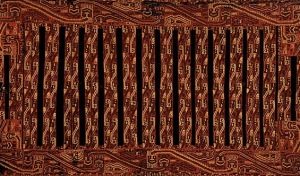
A recent study of an archaeological mound complex with astronomical orientations and geoglyph lines in southern Peru suggests that the site features a ceremonial or ritualistic center for religous and social interaction in an ancient culture that existed between 800 and 100 BCE.
Known as the Paracas culture, these ancient people constituted an Andean society known for extensive knowledge of irrigation and water management. The Chincha Valley, about 200 km south of Lima, contains early settlements of the Paracas culture. Previous surveys have indicated at least 30 major Paracas period sites or centers in the valley.
Recenty, a study team co-led by Charles Stanish of the Cotsen Institute of Archaeology and Department of Anthropology, University of California, surveyed and test-excavated among five previously identified mound clusters in the lower Chincha mid-valley area. Dating them based on excavated pottery to the Late Paracas period (400 – 100 BCE), they found that the mounds featured a total of 71 geoglyph lines that radiated outward from the mounds, forming what they called “ray centers”. Two of the mounds, built in a u-shape configuration, were oriented toward the location of the sun at the June solstice. Stanish and colleagues suggest that it all represents construction for specific group or societal purposes, the details of which are thus far lost to time. But the signs appear to be unmistakeable. Write Stanish, et al:
In Chincha, linear geoglyphs, platform mounds, and walls on those ceremonial mounds mark the June solstice. If it were only lines, then one could argue that the few solstice alignments were due to chance. However, the combination of platform mounds built in orientation with the June solstice, similarly positioned wall alignments, and comparative evidence from other regions in the Andes that documents solstice marking at sites contemporary with the Paracas period, makes purposeful construction the most parsimonious explanation. Based on these data, there is little doubt that marking the June solstice is an Andean tradition that was part of the logic of ceremonial mound construction and the creation of linear geoglyphs in pre-Hispanic Chincha during Paracas times.*
Ancient geoglyphs in Peru are most commonly associated with the famous Nazca Lines located in the Nazca Desert of southern Peru. Thought to have been created by the Nazca culture between 400 and 650 AD, scholars have developed a number of theories explaining their existence, with the greatest consensus revolving around religious practices or beliefs. But with recent discoveries related to the earlier Paracas culture, the picture is becoming a bit clearer, with the construction tradition appearing to be more ancient and more widespread.
“The ritualized landscape publically attested to particular platform mound sites as focal points for social gatherings, but it was also a product of these gatherings,” write Stanish, et al. “The act of creating geoglyphs within the broader ritualized landscape—the physical piling and clearing of rocks and soil—may be a key component of individual participation in such events. The specific nature of these social events remains obscure and will be the focus of our future research.”*
The study report has been published in the Proceedings of the National Academy of Sciences at http://www.pnas.org/cgi/doi/10.1073/pnas.1406501111
*Article #14-06501: “A 2,300-year-old architectural and astronomical complex in the Chincha Valley, Peru,” by Charles Stanish, Henry Tantaleán, Benjamin T. Nigra, and Laura E. Griffin.
Cover Photo, Top Left: Mantle — Peru, Paracas — 200 BCE – 200 CE, Wikimedia Commons
_________________________________________
Read about the most fascinating discoveries with a premium subscription to Popular Archaeology Magazine. Find out what Popular Archaeology Magazine is all about. AND MORE:
On the go? Purchase the mobile version of the current issue of Popular Archaeology Magazine here for only $2.99.
Popular Archaeology’s annual Discovery Edition eBook is a selection of the best stories published in Popular Archaeology Magazine in past issues, with an emphasis on some of the most significant, groundbreaking, or fascinating discoveries in the fields of archaeology and paleoanthropology and related fields. At least some of the articles have been updated or revised specifically for the Discovery edition. We can confidently say that there is no other single issue of an archaeology-related magazine, paper print or online, that contains as much major feature article content as this one. The latest issue, volume 2, has just been released. Go to the Discovery edition page for more information.






